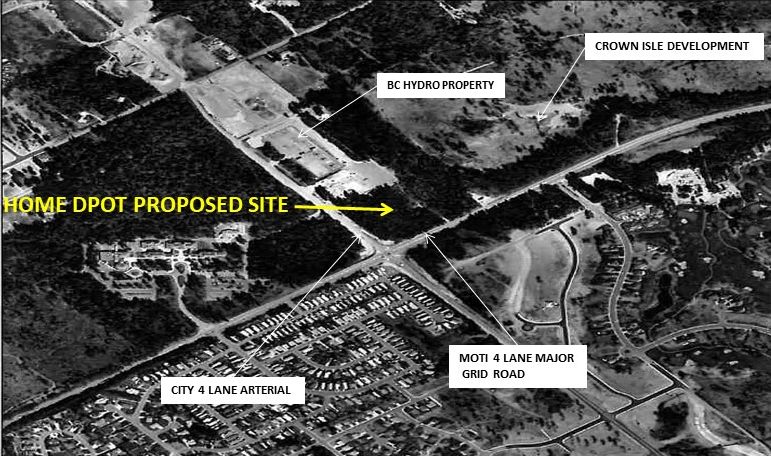FLASHBACK TO 2004: An approval by Agricultural Land Commission for Home Depot project in Courtenay required use of “Water Balance Model for British Columbia” to establish, test and meet performance targets for capturing rain on-site, where it falls, to protect agricultural lands downhill
Note to Readers:
In October 2010, the Okanagan Basin Water Board (OBWB) and the BC Water and Waste Association co-hosted a 2-day workshop titled ‘From Rain to Resource: Stormwater Management in a Changing Climate‘. Day 1 was geared toward technical operational and planning staff . The focus was on site-level best practices and tools to deal with various situations. One of the case studies was the Home Depot development in the City of Courtenay.
In 2004, the Home Depot project was one of the earliest applications of the Water Balance Methodology pursuant to Stormwater Planning: A Guidebook for British Columbia. The Agricultural Land Commission linked its approval, for removal of land from the Agricultural Land Reserve, to use of the Water Balance Model
Kevin Lagan tells the story of the first deep-well application of rainwater runoff to be implemented in British Columbia
“In 2003, the Home Depot development application in the City of Courtenay was to build a store and parking lot covering 90% of a four hectare second growth coniferous forest property,” reports Kevin Lagan, Director of Operational Services. He will tell the Home Depot story at the Okanagan From Rain to Resource Workshop.
Capture Rain Where It Falls
“The City required that post-development rainwater and stormwater flows leaving the site were equal to or less than the pre-development flows. For this property that was effectively zero.”
“ How did the developer meet this requirement of replacing a forest with impervious areas and has the solution been successful? Learn about the challenges encountered and the innovative solution used.”
How did the developer meet this requirement of replacing a forest with impervious areas and has the solution been successful? Learn about the challenges encountered and the innovative solution used.”
“Home Depot established a BC precedent when it implemented a deep deep-well system for injecting rainwater runoff and recharging the underlying groundwater aquifer.”
To Learn More:
Download a PDF copy of Innovative On-Site Rainwater/Stormwater Measures at a Commercial Site, the PowerPoint presentation by Kevin Lagan.
Read Innovation in the Comox Valley: First Wal-Mart, Then Home Depot, posted on waterbucket.ca in October 2007 — The Wal-Mart development in the City of Courtenay precipitated the beginning of a major change in how the City administers the zoning/development/approval process, collaborates with other agencies and also manages the rainwater resource.






An Early Application of the Water Balance Model
 “The Home Depot project was one of the earliest applications of the Water Balance Model when we created this web-based tool in 2003. Significantly, Home Depot is situated on high ground that drains onto prime agriculture land. Because the City of Courtenay was a charter member of the Inter-Governmental Partnership, the Agricultural Land Commission linked its approval to use of the Water Balance Model,” recalls Ted van der Gulik, Chair.
“The Home Depot project was one of the earliest applications of the Water Balance Model when we created this web-based tool in 2003. Significantly, Home Depot is situated on high ground that drains onto prime agriculture land. Because the City of Courtenay was a charter member of the Inter-Governmental Partnership, the Agricultural Land Commission linked its approval to use of the Water Balance Model,” recalls Ted van der Gulik, Chair.
“Subsequently, the City co-hosted one of our first Water Balance Model training workshops at North Island College in May 2004. The target audience was the streamkeeper commmunity. Our purpose was to demonstrate how this decision support tool can be used by a range of stakeholders.”
To Learn More:
Click on 2004 decision by Agricultural Land Commission was conditional upon use of Water Balance Model to download the January 2004 news release.
Click on Thinking Outside the Pipe in the Comox Valley to read a newspaper report about the training workshop co-hosted by the City of Courtenay and the Millard/Piercy Watershed Stewards.

2004 Water Balance Model Workshop, North Island College

Kevin Lagan shares his perspective at 2004 WBM Workshop



